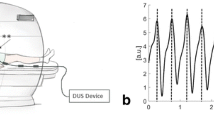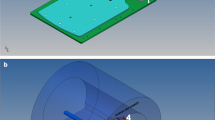Abstract
Purpose
To investigate the self-gating technique for MR imaging of the fetal heart in a sheep model.
Material and Methods
MR images of 6 fetal sheep heart were obtained at 1.5T. For self-gating MRI of the fetal heart a cine SSFP in short axis, two and four chamber view was used. Self-gated images were compared with real cardiac triggered MR images (pulse-wave triggering). MRI of the fetal heart was performed using both techniques simultaneously. Image quality was assessed and the left ventricular volume and function were measured and compared.
Results
Compared with pulse-wave triggering, the self-gating technique produced slightly inferior images with artifacts. Especially the atrial septum could not be so clearly depicted. The contraction of the fetal heart was shown in cine sequences in both techniques. The average blood volumes could be measured with both techniques with no significant difference: at end-systole 3.1 ml (SD± 0.2), at end-diastole 4.9 ml (±0.2), with ejection fractions at 38.6%, respectively 39%.
Conclusion
Both self-gating and pulse-wave triggered cardiac MRI of the fetal heart allowed the evaluation of anatomical structures and functional information. Images obtained by self-gating technique were slightly inferior than the pulse-wave triggered MRI.




Similar content being viewed by others
References
Blondin D, Schaper J, Klee D et al (2008) Evaluation of malformations of the fetal central nervous system using fetal MRI. Rofo 180:715–721
Coakley FV, Glenn OA, Qayyum A, Barkovich AJ, Goldstein R, Filly RA (2004) Fetal MRI: a developing technique for the developing patient. AJR Am J Roentgenol 182:243–252
Coakley FV, Hricak H, Filly RA, Barkovich AJ, Harrison MR (1999) Complex fetal disorders: effect of MR imaging on management–preliminary clinical experience. Radiology 213:691–696
Huisman TA, Wisser J, Martin E, Kubik-Huch R, Marincek B (2002) Fetal magnetic resonance imaging of the central nervous system: a pictorial essay. Eur Radiol 12:1952–1961
Guo WY, Wong TT (2003) Screening of fetal CNS anomalies by MR imaging. Childs Nerv Syst 19:410–414
Guo Y, Luo BN (2006) The state of the art of fetal magnetic resonance imaging. Chin Med J (Engl) 119:1294–1299
Chang CH, Yu CH, Chang FM, Ko HC, Chen HY (2003) Volumetric assessment of normal fetal lungs using three-dimensional ultrasound. Ultrasound Med Biol 29:935–942
Chang CH, Yu CH, Chang FM, Ko HC, Chen HY (2003) Three-dimensional ultrasound in the assessment of normal fetal thigh volume. Ultrasound Med Biol 29:361–366
Meyer-Wittkopf M (2002) Interventional fetal cardiac therapy – possible perspectives and current shortcomings. Ultrasound Obstet Gynecol 20:527–531
Meyer-Wittkopf M, Cook A, McLennan A, Summers P, Sharland GK, Maxwell DJ (1996) Evaluation of three-dimensional ultrasonography and magnetic resonance imaging in assessment of congenital heart anomalies in fetal cardiac specimens. Ultrasound Obstet Gynecol 8:303–308
Deng J, Rodeck CH (2006) Current applications of fetal cardiac imaging technology. Curr Opin Obstet Gynecol 18:177–184
Deng J, Rodeck CH (2004) New fetal cardiac imaging techniques. Prenat Diagn 24:1092–1103
Yamamura J, Schnackenburg B, Kooijmann H, Frisch M, Hecher K, Adam G, Wedegärtner U (2009) High resolution MR imaging of the fetal heart with cardiac triggering: a feasibility study in the sheep fetus. Eur Radiol 19(10):2383–90
Gharib AM, Herzka DA, Ustun AO et al (2007) Coronary MR angiography at 3T during diastole and systole. J Magn Reson Imaging 26:921–926
Gharib AM, Ho VB, Rosing DR et al (2008) Coronary artery anomalies and variants: technical feasibility of assessment with coronary MR angiography at 3T. Radiology 247:220–227
Finn JP, Nael K, Deshpande V, Ratib O, Laub G (2006) Cardiac MR imaging: state of the technology. Radiology 241:338–354
Cury RC, Shash K, Nagurney JT et al (2008) Cardiac magnetic resonance with T2-weighted imaging improves detection of patients with acute coronary syndrome in the emergency department. Circulation 118:837–44
Ebeling Barbier C, Bjerner T, Hansen T, Nabaei SM (2007) Clinically unrecognized myocardial infarction detected at MR imaging may not be associated with atherosclerosis. Radiology 245:103–110
Nijm GM, Swiryn S, Larson AC, Sahakian AV (2008) Extraction of the magnetohydrodynamic blood flow potential from the surface electrocardiogram in magnetic resonance imaging. Med Biol Eng Comput 46:729–733
Larson AC, White RD, Laub G, McVeigh ER, Li D, Simonetti OP (2004) Self-gated cardiac cine MRI. Magn Reson Med 51:93–102
Crowe ME, Larson AC, Zhang Q et al (2004) Automated rectilinear self-gated cardiac cine imaging. Magn Reson Med 52:782–788
Holmes WM, McCabe C, Mullin JM, Condon B, Bain MM (2009) In ovo non-invasive quantification of the myocardial function and mass of chick embryos using magnetic resonance imaging. NMR Biomed 22(7):745–52
Nieman BJ, Szulc K, Turnbull DH (2009) Three-dimensional, in vivo MRI with self-gating and image coregistration in the mouse. Magn Reson Med 61:1148–1157
Gorincour G, Bourliere-Najean B, Bonello B et al (2007) Feasibility of fetal cardiac magnetic resonance imaging: preliminary experience. Ultrasound Obstet Gynecol 29:105–108
Saleem SN (2008) Feasibility of MRI of the fetal heart with balanced steady-state free precession sequence along fetal body and cardiac planes. AJR Am J Roentgenol 191:1208–1215
Manganaro L, Savelli S, Di Maurizio M et al (2008) Potential role of fetal cardiac evaluation with magnetic resonance imaging: preliminary experience. Prenat Diagn 28:148–156
Fogel MA, Wilson RD, Flake A et al (2005) Preliminary investigations into a new method of functional assessment of the fetal heart using a novel application of ‘real-time’ cardiac magnetic resonance imaging. Fetal Diagn Ther 20:475–480
Larson AC, White R, Laub G, McVeigh ER, Li D, Simonetti OP (2004) Self-gated cardiac cine MRI. Magn Reson Med 51:93–102
Spraggins TA (1990) Wireless retrospective gating: application to cine cardiac imaging. Magn Reson Imaging 8:675–681
Crowe ME, Larson A, Zhang Q, Carr J, White RD, Li D, Simonetti OP (2004) Automated rectilinear self-gated cardiac cine imaging. Magn Reson Med 52:782–788
Nijm GM, Sahakian A, Swiryn S, Carr JC, Sheehan JJ, Larson AC (2008) Comparison of self-gated cine MRI retrospective cardiac synchronization algorithms. J Magn Reson Imaging 28:767–772
Hiba B, Richard N, Thibault H, Janier M (2007) Cardiac and respiratory self-gated cine MRI in the mouse: comparison between radial and rectilinear techniques at 7T. Magn Reson Med 58:745–753
Author information
Authors and Affiliations
Corresponding author
Rights and permissions
About this article
Cite this article
Yamamura, J., Frisch, M., Ecker, H. et al. Self-gating MR imaging of the fetal heart: comparison with real cardiac triggering. Eur Radiol 21, 142–149 (2011). https://doi.org/10.1007/s00330-010-1911-7
Received:
Revised:
Accepted:
Published:
Issue Date:
DOI: https://doi.org/10.1007/s00330-010-1911-7




